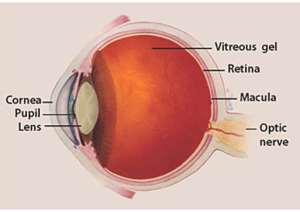
The global prevalence of glaucoma for population aged 40-80 years is about 3.4%. In 2013, the number of people aged 40-80 years with glaucoma worldwide was estimated to be about 64.3 million, increasing to about 76 million in 2020 and 111.8 million in 2040. The high incidence of glaucoma cannot be over-emphasized and so much awareness must be created for glaucoma.
My grandmother died of glaucoma because she had no knowledge of the disease. She thought it was a mere pain she felt in her eye so she refused to see an eye specialist upon being advised severally. My grandmother decided go to the hospital when she was partially blind but at that time the disease had progressed to the chronic stage with many complications. After some few years of being diagnosed of glaucoma, my lovely grandmother passed away. I am so passionate about glaucoma because of this incidence and would take every opportunity I get to educate people on glaucoma. Glaucoma is less talked about but I want to say it is one of the deadly diseases if not earlier diagnosed and treated.
To begin with, Glaucoma is a group of diseases that damage the eye’s optic nerve. The eye constantly makes aqueous humor . As new aqueous flows into your eye, the same amount should drain out. The fluid drains out through an area called the drainage angle . This process keeps pressure in the eye (called intraocular pressure or IOP) stable. But if the drainage angle is not working properly, fluid builds up. Pressure inside the eye rises, damaging the optic nerve . This can result in vision loss and blindness. However, with early detection and treatment, you can often protect your eyes against serious vision loss.
Some people have a higher than normal risk of getting glaucoma . This includes people who; are over age 40, have family history of glaucoma, have high eye pressure , are farsighted or nearsighted , have had an eye injury , use long-term steroid medications, have corneas that are thin in the center, have thinning of the optic nerve, have diabetes , migraines , high blood pressure , poor blood circulation or other health problems affecting the whole body.
Types of Glaucoma
The several types of glaucoma include; Open-Angle Glaucoma, Angle-Closure Glaucoma, Normal-Tension Glaucoma (NTG), and Congenital Glaucoma.
Symptoms of Glaucoma
Hazy or blurred vision
The appearance of rainbow-colored circles around bright lights
Severe eye and head pain
Nausea or vomiting (accompanying severe eye pain)
Sudden sight loss
Glaucoma could be asymptomatic asserting the reason why we should have regular checkups of the eye even if we have no eye problem.
Complications of glaucoma
Loss of Vision
Glaucoma is responsible for 1 in 10 cases of blindness.
Management of Glaucoma
The goal of glaucoma treatment is to prevent further vision loss by controlling pressure in the eye. Medication may come in the form of eye drops, pills. There are five major classes of drugs used in the treatment of glaucoma. These include acetylcholine receptor agonist, adrenoceptor agonist, carbonic anhydrase inhibitors, beta-adrenoceptor antagonist and prostaglandin analogues. Examples of drugs used in to treat glaucoma include; xalatan, lumigan, travatan.
Prevention
Maintain a healthy weight
Keep your blood pressure at normal levels
Control use of steroid medications
Cease smoking
Limit caffeine intake to moderate levels, because some evidence suggests that high amount of caffeine may increase eye pressure
Conclusion
In summary, glaucoma is a disease that damages the optic nerve associated with elevated intraocular pressure which could lead to vision loss if not earlier detected and treated. Health living such as; maintaining a healthy weight, exercising regularly, avoiding the use of steroid medication prevents an individual from high risk of glaucoma. It is important one sees an optometrist immediately if one suspect symptoms of glaucoma to prevent further complications. Treatment option for patient with glaucoma include medications, laser therapy, and incisional surgery.
Written By:
Ruth Akua Kesewaa
BSc. Physician Assistant Studies
University of Cape Coast




 SSNIT must be managed without gov’t interference – Austin Gamey
SSNIT must be managed without gov’t interference – Austin Gamey
 Ejisu by-election could go either way between NPP and independent candidate — Gl...
Ejisu by-election could go either way between NPP and independent candidate — Gl...
 We never asked ministers, DCEs to bring NPP apparatchiks for returning officer r...
We never asked ministers, DCEs to bring NPP apparatchiks for returning officer r...
 No one denigrated the commission when you appointed NDC sympathizers during your...
No one denigrated the commission when you appointed NDC sympathizers during your...
 Used cloth dealers protests over delayed Kumasi Central Market project
Used cloth dealers protests over delayed Kumasi Central Market project
 A/R: Kwadaso onion market traders refuse to relocate to new site
A/R: Kwadaso onion market traders refuse to relocate to new site
 Dumsor: Corn mill operators at Kaneshie market face financial crisis
Dumsor: Corn mill operators at Kaneshie market face financial crisis
 Jamestown fishermen seek support over destruction of canoes by Tuesday's heavy d...
Jamestown fishermen seek support over destruction of canoes by Tuesday's heavy d...
 Election 2024: EC to commence voter registration exercise on May 7
Election 2024: EC to commence voter registration exercise on May 7
 Public schools rebranding: We’re switching to blue and white, we’re painting all...
Public schools rebranding: We’re switching to blue and white, we’re painting all...
